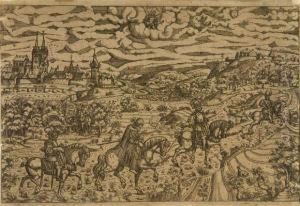Mathis Zundt Paintings
Mathis Zundt, also known as Matthes Zündt, was a German engraver and etcher born approximately in 1498 in Nuremberg, a city that was a hub of art and culture during the Renaissance period in Europe. His life and works are less documented than those of his more famous contemporaries, but his contributions to the art of engraving and printmaking are notable. He was active during the 16th century, a time when the art of engraving was evolving rapidly and becoming an important means of reproducing and disseminating images.
Zundt likely trained with other artists in the Nuremberg tradition, which included the likes of Albrecht Dürer, although there is no direct evidence linking their tutelage. His style, however, does reflect the influence of Dürer's work, as well as the broader Northern Renaissance movement. Zundt's engravings are characterized by their fine detail, use of hatching and cross-hatching for tonal effects, and often included religious and mythological themes, which were common subjects during this period.
Although Zundt's oeuvre is not extensive, his prints were quite influential in the dissemination of the Renaissance style across Europe. His works were collected and copied by other artists, helping to spread the new ideas and aesthetics of the Renaissance beyond Italy and into Northern Europe. Mathis Zundt's death is recorded as having occurred in 1572. Unfortunately, because his life was not as well-documented as those of some of his peers, much of what we know about Zundt comes from his surviving works and the influence they had on the printmaking tradition.
